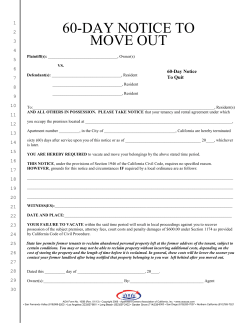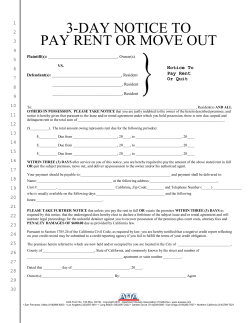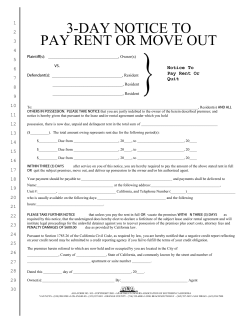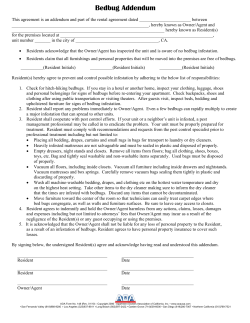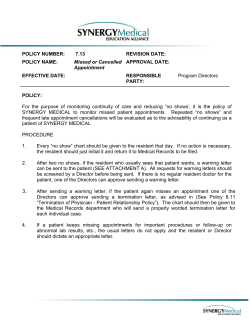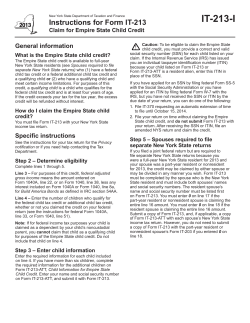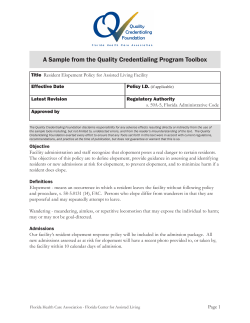
and How to Report Them!
It’s Still All About Falls and How to Report Them! The last few weeks’ articles have dealt with Fall prevention and management. Falls do happen though and, at times, need to be reported to IDPH. Although IDPH revised its Incident Reporting requirements several years ago, limiting required reporting to those ‘serious’ occurrences involving physical harm or injury, it is still essential to employ risk management savvy when incidents do have to be sent to IDPH! During educational sessions regarding revisions to F323, IDPH has made it very clear that the content of the notification to Public Health of a reportable incident is pivotal in IDPH’s determination as to whether an on-site visit will be made. Too little information and/or too much of the ‘wrong’ information and the surveyors will come knocking! Some facilities are still sending reportable incident summaries that read more like an invitation for an on-site visit than a risk management savvy summary. When it comes to notifying Public Health of a resident incident (‘occurrence’ or ‘event’ are less inflammatory descriptives), some facilities continue to subscribe to the ‘less said the better’ philosophy. Believing that communicating a minimum of details will somehow protect them from surveyor scrutiny, these facilities are in fact sending an engraved invitation for an incident review inspection. Example of a ‘less said the better’ incident summary sent to Public Health: At approximately 2:30PM resident’s daughter notified nurse of appearance of resident’s left hip and thigh. Area noted to be swollen. MD notified and resident sent to ER for evaluation. Dx L hip fracture. Now, put yourself in the reviewer’s shoes. Do you have questions? I hope so! At the top of the list should be how could this have occurred? Did the resident have a fall during the day/days prior to discovery? What is the resident’s ambulation and transfer status? Could the resident have fallen and gotten up without notifying staff? Could the resident have fallen and staff failed to report the event to the nurse? Could the resident have been lowered to the floor by staff who failed to report the event? Cognitive status? Behavioral patterns? Is the resident resistant to care? Could this fracture have occurred during a combative episode? Could this injury be the result of abuse? What is the resident’s baseline medical diagnoses/physical condition? Did the resident have signs/symptoms of change in condition, i.e. change in ability to ambulate, transfer, etc.? Did the resident have complaints of pain prior to discovery? Why did the daughter notice the condition of the left hip area but nursing staff did not? Where was the resident located when the daughter made this observation? How long could the resident have been in this condition prior to discovery? Did the facility conduct any form of investigation to determine the cause/probable cause of the fracture? Were revisions made to the Care Plan as a result of the investigation? In the presence of all of these unanswered questions, a surveyor visit is inevitable. Will this facility be ready? Another unanswered question! It is always good risk management practice to line up your defenses prior to and/or to prevent an attack: Example of a ‘facts, conclusions, no unanswered questions’ event summary: At approximately 2:30PM, the resident was noted by licensed nursing staff to be in her room, seated in her wheelchair visiting with daughter. Licensed nursing staff assessed her left hip area to be swollen with internal rotation. The attending physician was immediately notified and orders were received to send resident to the emergency room for evaluation and treatment as indicated. The resident was subsequently admitted to the hospital with diagnosis of left hip fracture. Review of the resident’s medical history indicates a diagnosis of severe osteoporosis and pre-admission history of multiple fractures occurring over a several year period to sites including right hip, pelvis, ribs, etc. The facility immediately initiated a comprehensive investigation including but not limited to interview of all staff on duty preceding and during the day of discovery. Upon review of the resident’s activities, care and treatment during this time period, the following was determined: There was no fall event and/or unusual occurrence. o The resident is/has been consistently cooperative with care rendered by staff, participates in transfer with assistance of one, self-propels in the wheelchair and is capable of maker her needs known and communicating pain/discomfort to staff. The resident participated in activities of daily living in accordance with her baseline. Appetite and pursuit of/participation in leisure activities were unchanged. The resident evidenced no complaints of discomfort that were inconsistent with her existing diagnoses and baseline. The resident did not request/receive any pain medications in frequencies that were a departure from her customary regimen. The resident was observed/assessed by licensed nurses on numerous occasions during the days preceding and including the day of discovery consistent with the facility’s customary practice and in reference to symptoms of possible upper respiratory infection. On the day of discovery, resident received AM care and was transferred from bed to wheelchair without incident. Resident ate breakfast and lunch in the main dining room with usual consumption and participated in scheduled morning activities. CNA staff caring for the resident during the day shift and preceding evening/night shifts indicated that there was no swelling observed to the left hip/thigh area. CNA staff caring for the resident in the days prior to and on day of discovery performed return demonstration of care techniques including but not limited to transfer, repositioning in bed, etc. Care techniques were performed commensurate with facility policy/procedure and current practice standards. As a result of the facility’s comprehensive investigation, the facility and attending physician have concluded that, in the absence of a fall event and/or unusual occurrence and consistent with the presence of severe osteoporosis, the fracture was likely to be spontaneous in nature, occurring during normal activity and weight bearing. The resident’s care plan has been reviewed and revised relative to this event including but not limited to the use of mechanical lift, etc. As you will notice, the strategy is to answer any questions before the surveyor/reviewer has a chance to think of them! It’s like developing an Informal Dispute Resolution before you receive the Statement of Deficiencies. Note: The de-emphasis on the fact that the daughter brought the hip swelling to the nursing staff’s attention. The emphasis on the ‘immediacy’ of actions taken including assessment, MD notification, and initiation of an investigation. The emphasis on on-going licensed nurse assessment. The comprehensive nature of the investigation is clear. The introduction of medical opinion in support of the facility’s conclusions. The overall impression is that the facility was proactive, prompt, and comprehensive in its evaluation of the occurrence. This impression supports the credibility of the facility’s conclusion. The less said can be too little! Enough said can be just right! About the Author: Dorrie J. Seyfried is Vice President of Method Management, Risk Management & LTC Consultants, based in St. Charles, Illinois. Under her direction, the Method Management team provides risk management services to workers compensation trusts and liability insurance risk retention groups, as well as a comprehensive array of consultation services to long term care providers, including mock surveys, plan of correction & informal dispute resolution development, incident management, leadership development, and a 24-hour risk management hotline exclusively for LSN members! Dorrie’s direct line: 630-485-5920 Dorrie’s direct fax: 630-485-5921 Email address: dorrie@methodmgmt.com
© Copyright 2025
